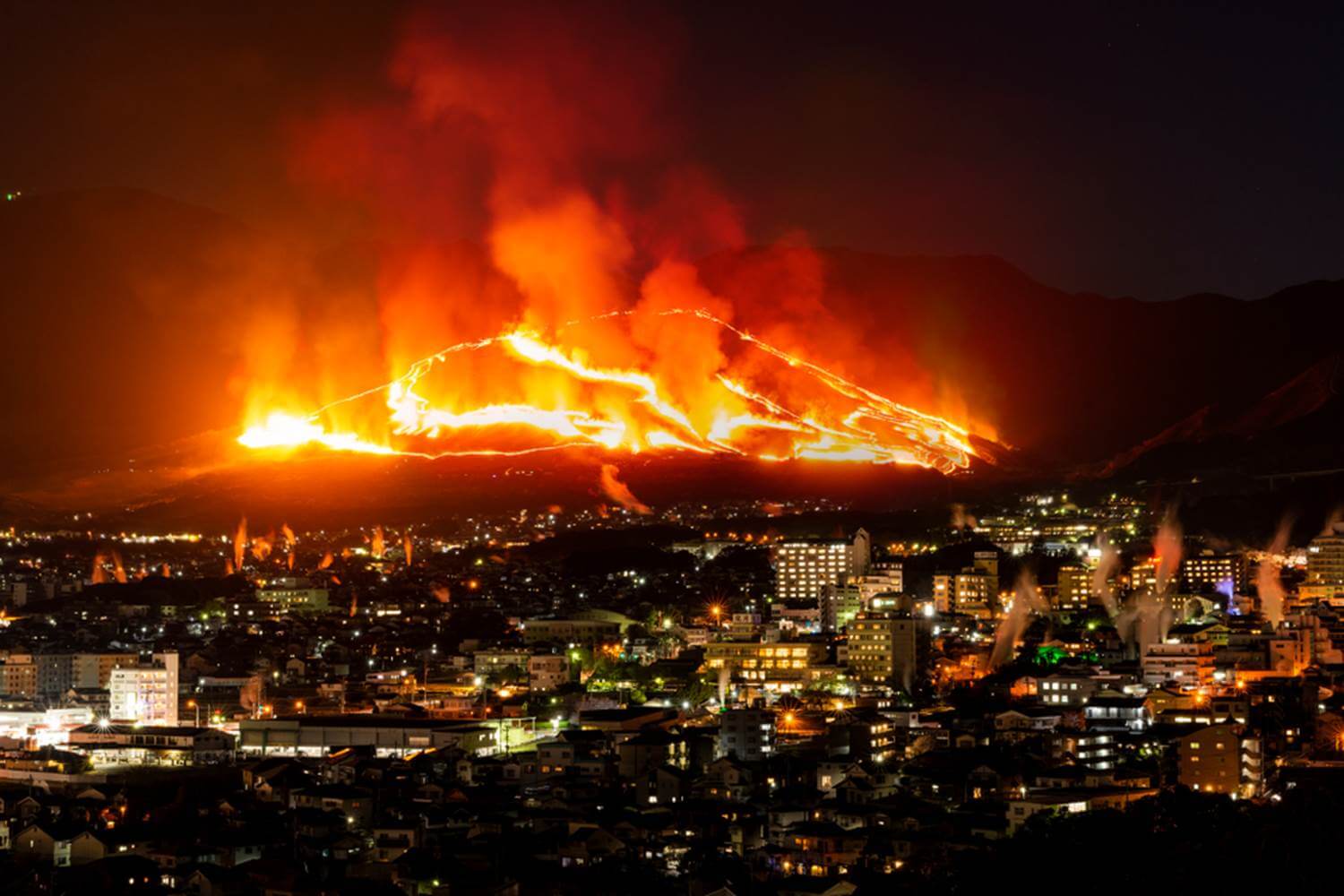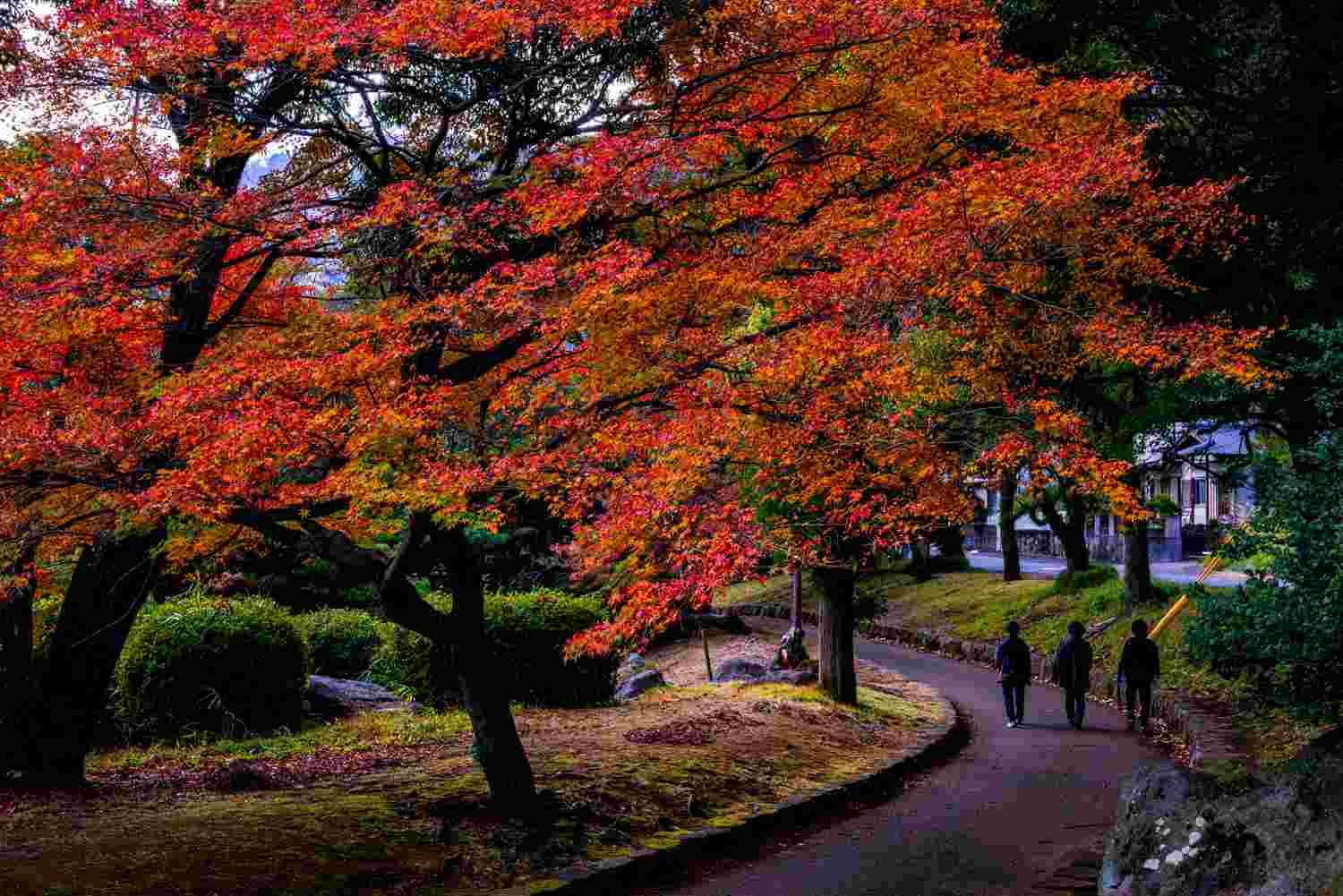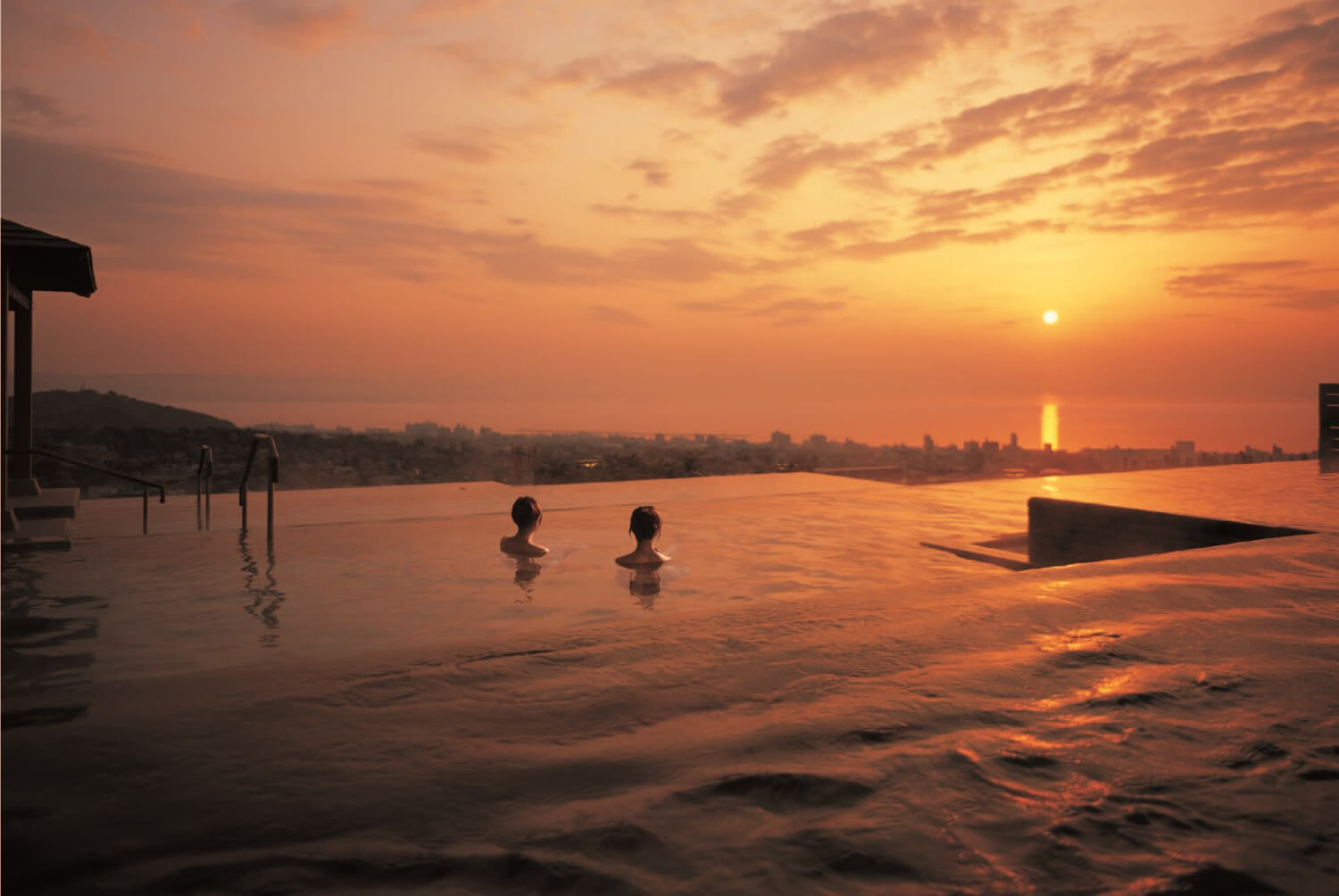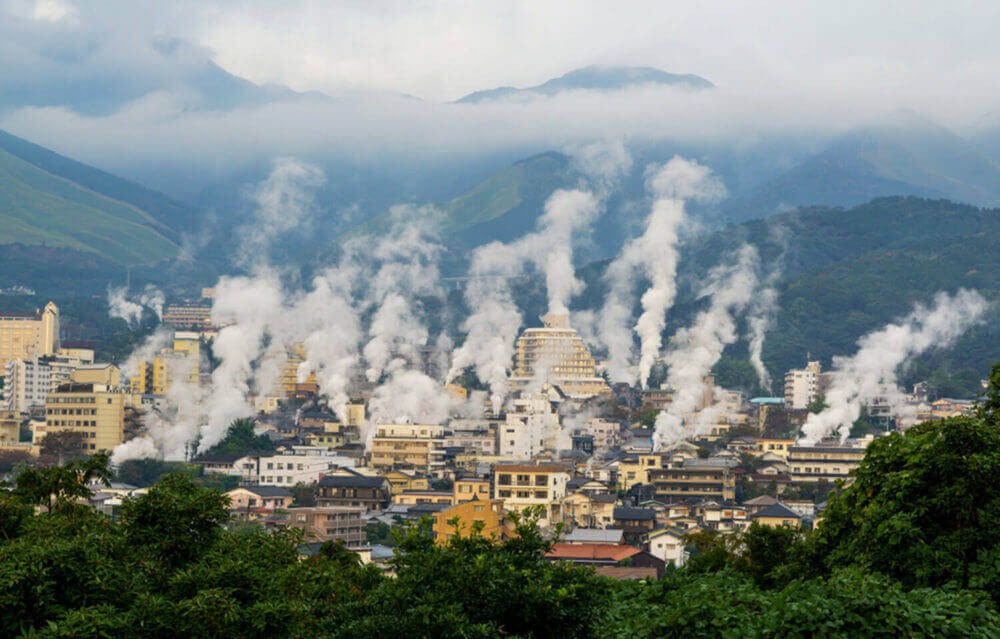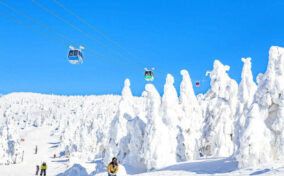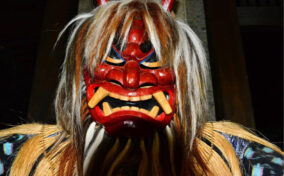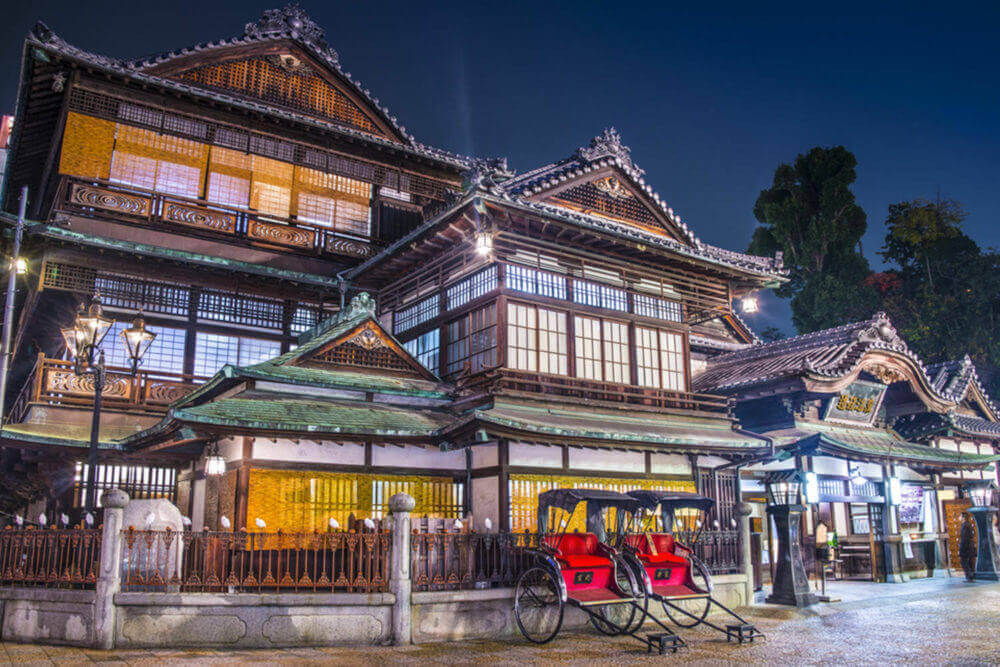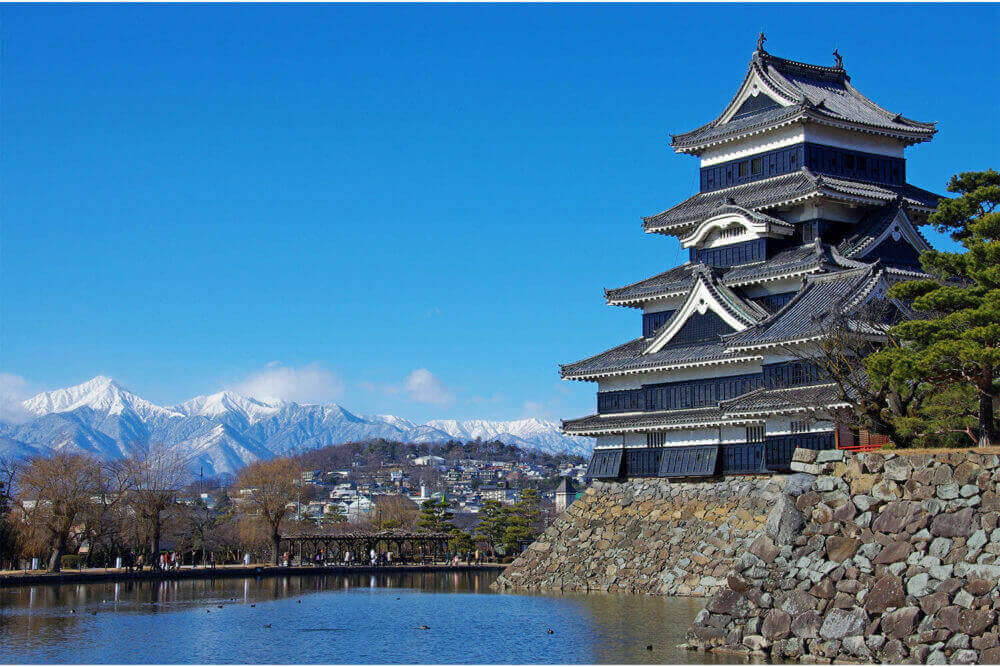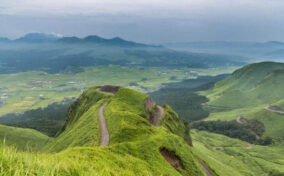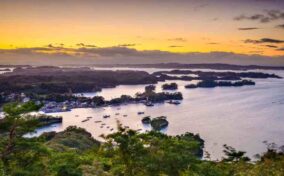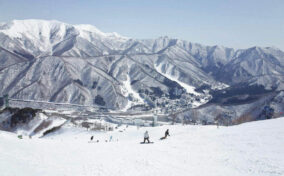Beppu (別府), Oita Prefecture, is Japan’s largest hot spring resort. If you want to fully enjoy Japanese hot springs, you might want to add Beppu to your itinerary. Beppu has a very large amount of hot water and there are various types of hot springs. In addition to the large public baths, there are private baths in the guest rooms and huge outdoor baths with swimsuits. On this page, we will guide you on your trip to Beppu, including the attractions of Beppu, places to go and things to do.
Table of Contents
Photos
Outline of Beppu
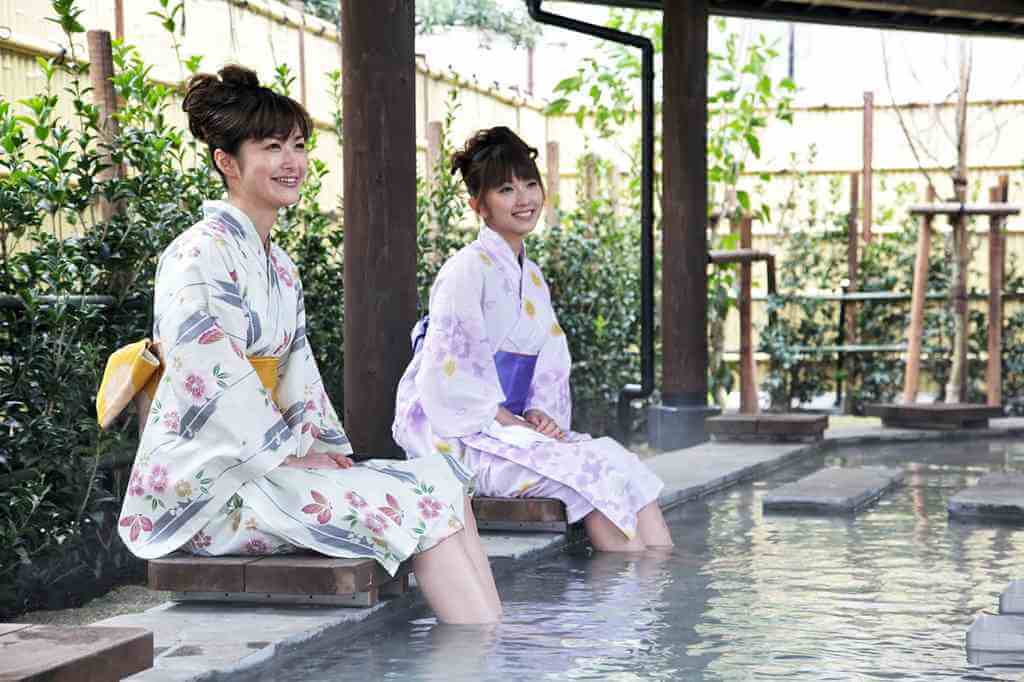
There are small outdoor baths everywhere in Beppu. These are the “Ahiyu (footbaths)” where you can easily bathe your feet.
Beppu is Japan’s largest hot spring resort area. The amount of hot spring water that springs from Beppu is the second largest in the world after Yellowstone in the United States. Beppu covers an area of 125.34 square kilometers, which is only 1 / 70th of Yellowstone. When you visit Beppu, you will be amazed at how much hot spring water is spouting here.
Beppu has been known as Japan’s leading hot spring resort for a long time. Various types of hot springs have been used for bathing. Furthermore, strangely colored hot springs such as “Umi-Jigoku (sea hell)” and “Chinoike-Jigoku (blood pond hell)” have attracted people as view spots.
Today, more than 8 million tourists visit Beppu each year. There are many hotels and Ryokan in Beppu to welcome these guests. Beppu is compared to the nearby Yufuin. Yufuin is a quiet hot spring resort. In contrast, Beppu is a lively resort town with a huge number of hotels and amusement facilities.
>>Find the Beppu best deal, compare prices, and read what other travelers have to say at Tripadvisor
Recently, luxury resort hotels and other facilities have opened on hills away from central Beppu. It may be a good idea to relax at one of these hotels.
Where is Beppu?
Beppu is located on the eastern coast of Kyushu. It is very close to Oita City, the prefectural capital of Oita Prefecture. It takes about 30 minutes by car or train from Oita city center to Beppu.
Traffic access
By air
Oita Airport → Beppu: 40 minutes by limousine bus
Haneda Airport (Tokyo) → Oita Airport: 1 hour 30 minutes
Narita Airport (Tokyo) → Oita Airport: 2 hours
Itami Airport (Osaka) → Oita Airport: 1 hour
*Check flights to and from Oita Airport with Skyscanner
By train
JR Tokyo Station → JR Beppu Station: 6 hours
Tokyo → Kokura: Shinkansen
Kokura → Beppu: the Sonic limited express train
If you want to travel around Beppu, a rail pass that allows unlimited rides on the Shinkansen and local trains is a great deal. >>See here for details.
Recommended tourist spots
Beppu Hatto(別府八湯)
There are hundreds of hot springs in Beppu city. Among them, the eight large hot springs listed below have been collectively called “Beppu Hatto” (meaning eight hot springs in Beppu) for a long time. Beppu Hatto has different types of hot springs. Furthermore, the atmosphere as a hot spring area is also different. When you come to Beppu, please enjoy various types of hot springs.
Beppu Onsen(別府温泉)
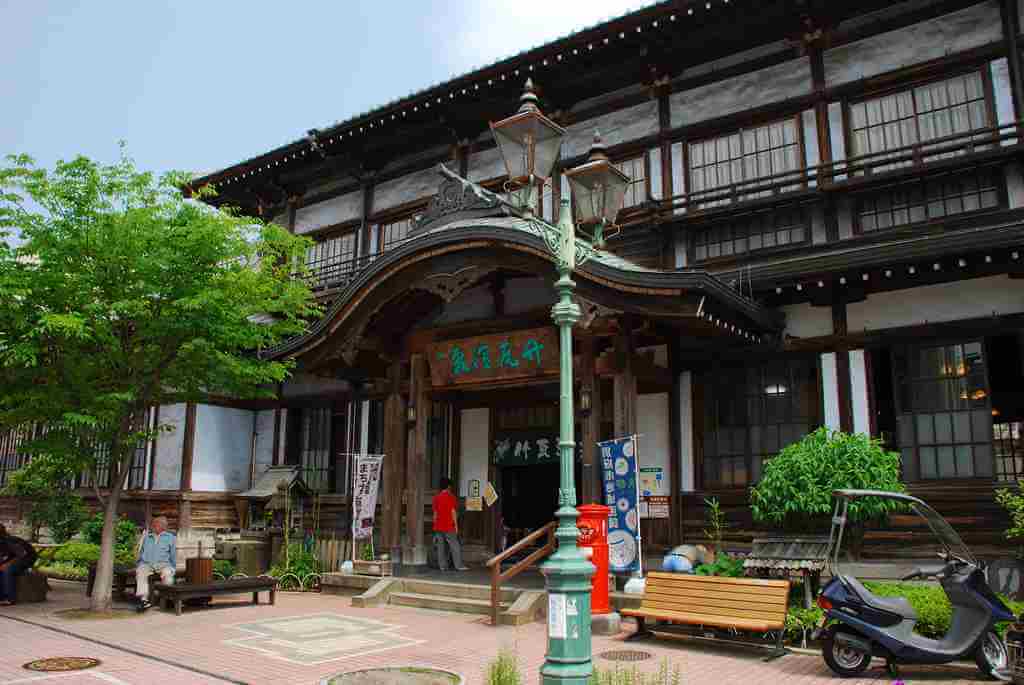
Takegawara Onsen in Beppu
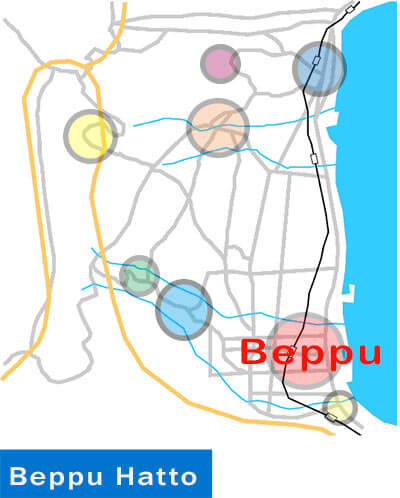
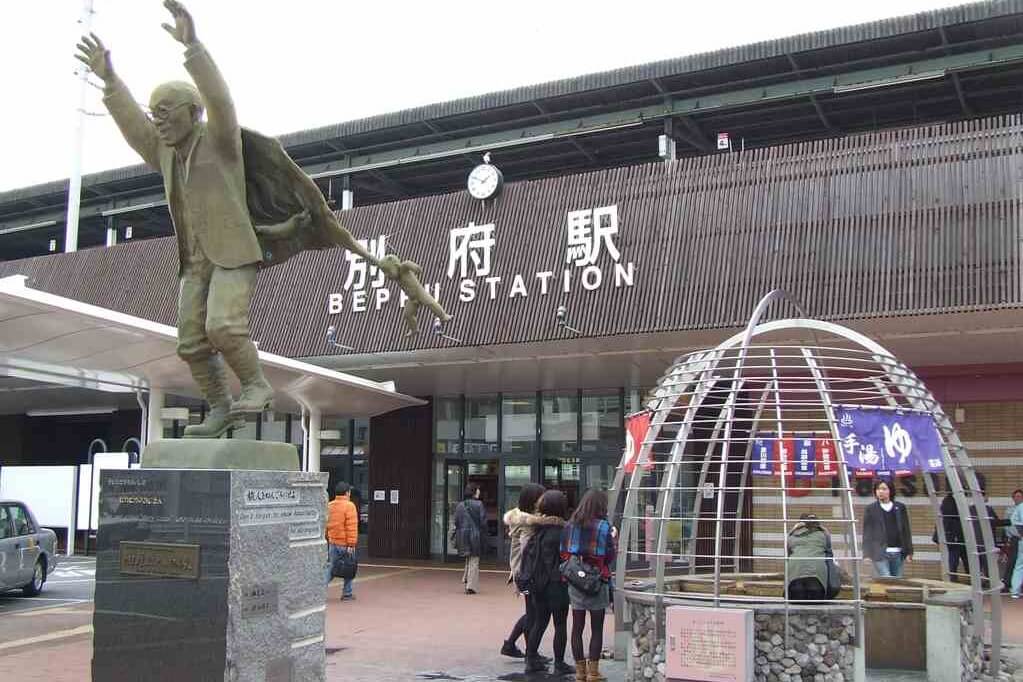
Beppu Japan Railway Station with Statue of Kumahachi Aburaya or the shiny uncle Located in front of the station
Beppu Onsen is a hot spring town located around JR Beppu Station, and is the area with the most entertaining elements of Beppu Hatto. There is also a historic public bathhouse “Takegawara Onsen” built in 1938, which is a symbolic building of this town.
>>Check out accommodations on Beppu Onsen with Skyscanner!
Myoban Onsen(明礬温泉)
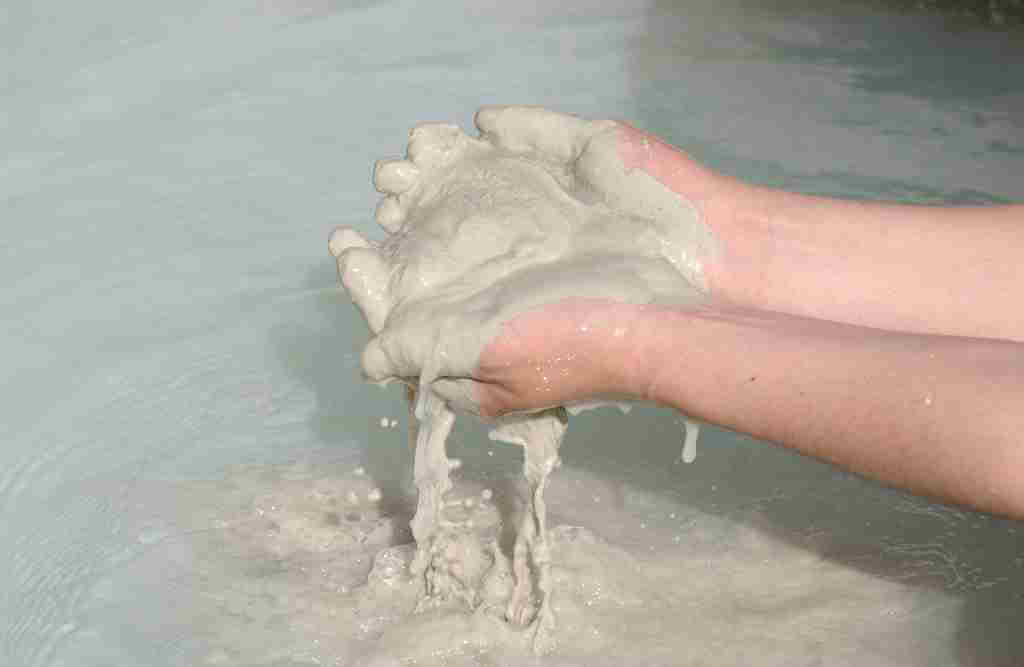
“Beppu Onsen Hoyoland”. in Myoban Onsen, Beppu, Japan
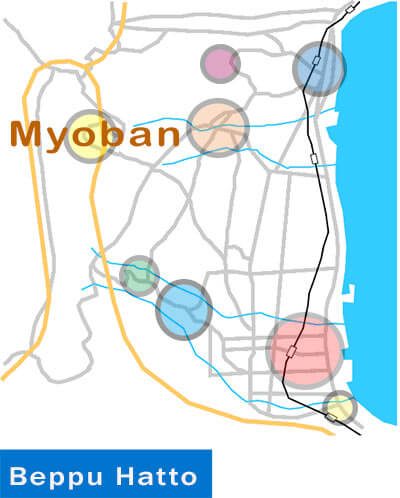
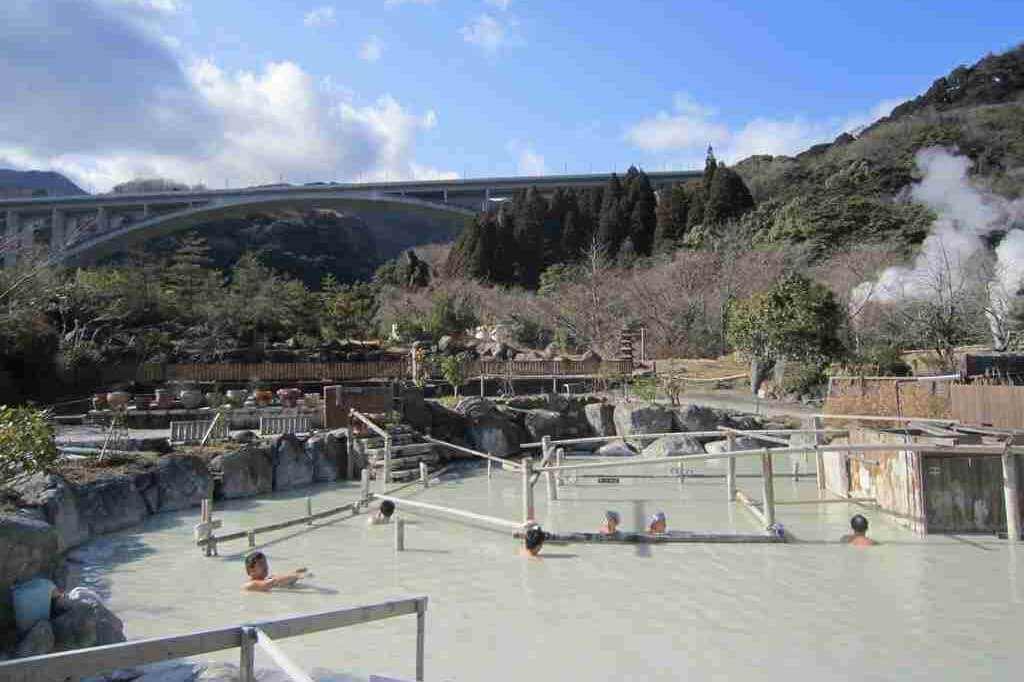
“Beppu Onsen Hoyoland” in Myoban Onse. This outdoor bath is a unisex hot spring
Myoban Onsen is located on a hill, far from the center of Beppu. “Myoban” means the Yunohana or Alum. It was named because Alum had been collected in this district.
The district also includes Beppu Onsen Hoyoland, famous for its Mixed Mud Baths. Here you can experience milky white onsen and a mud bath. Further outdoors, you can use an outdoor mixed mud bath as seen in the pictures above. This open-air bath is a traditional mixed gender hot spring.
A high-class resort hotel, “ANA Intercontinental Beppu Resort & Spa,” has recently opened on a hill, a little far from the center of Myoban Onsen. The view from this hotel is amazing.
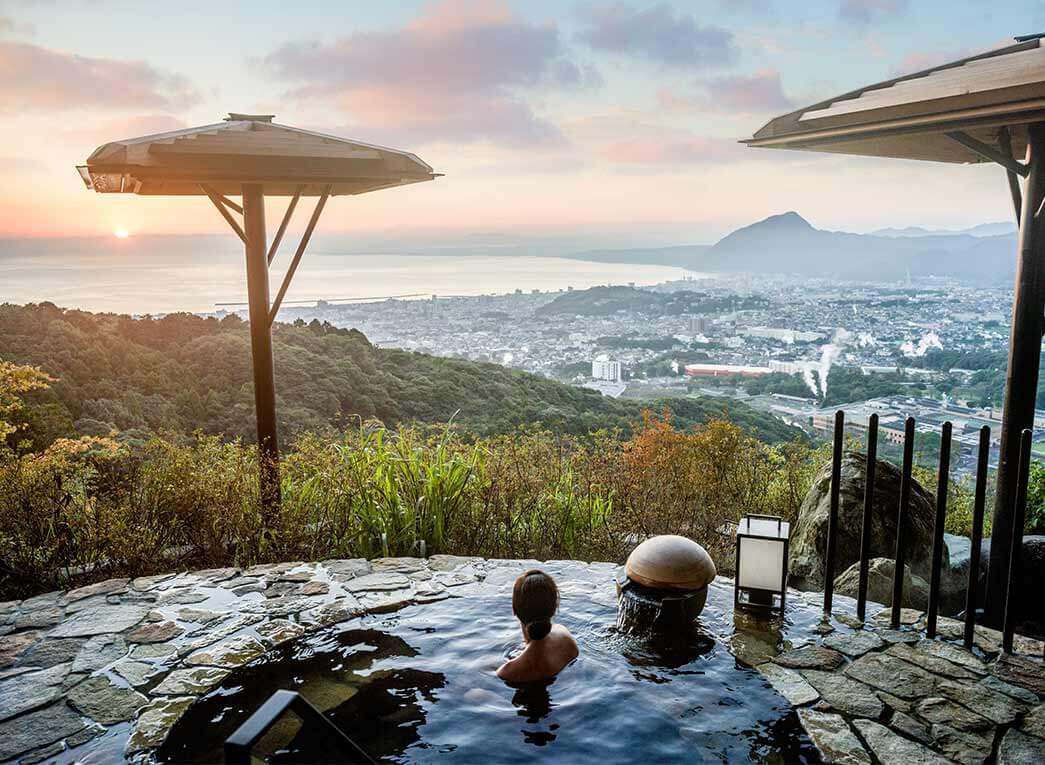
ANA InterContinental Beppu Resort & Spa in Beppu= Source: https://anaicbeppu.com/en/
Kannawa Onsen(鉄輪温泉)
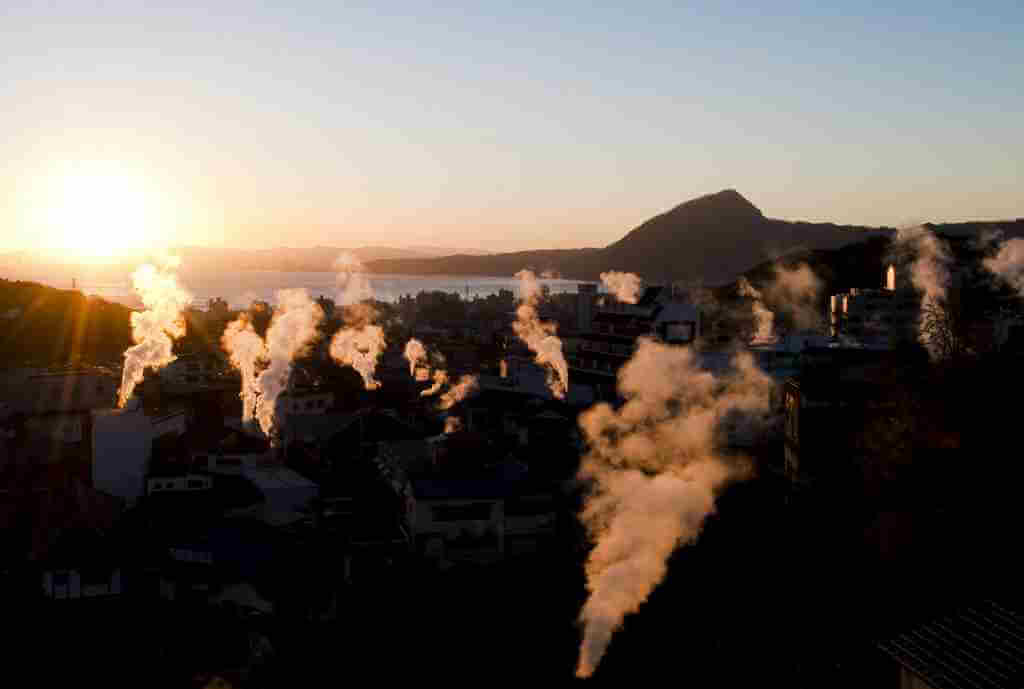
Beautiful landscape of Kannawa Onsen
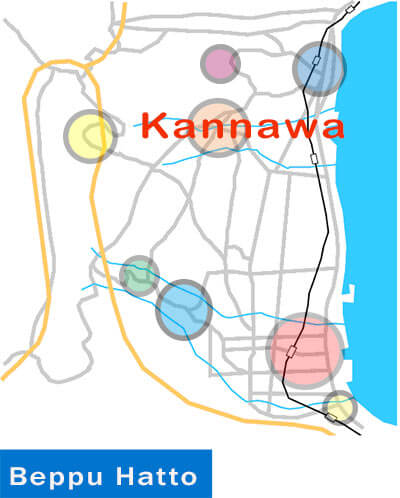
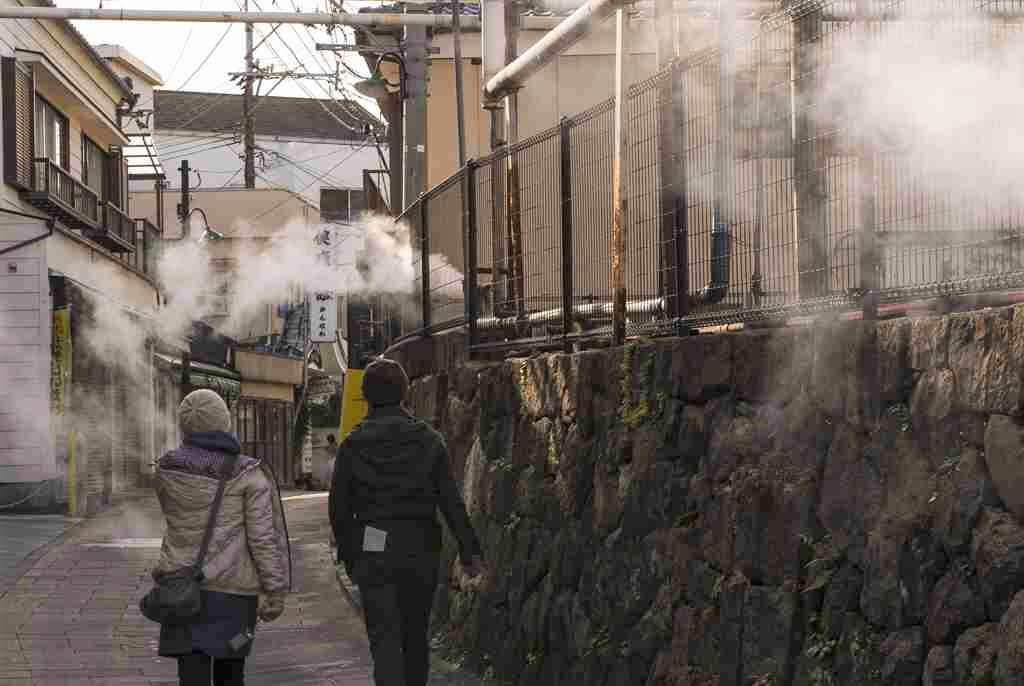
At Kannawa Onsen, steam is rising from everywhere
Kannawa Onsen, along with Myoban Onsen, is a district that retains the atmosphere of a traditional hot spring town. It is located between the center of Beppu and Myoban Onsen.
There are many Jigoku (hell = strangely colored hot springs), which are the highlights of Beppu tourism. Also nearby is the Yukemuri Observatory, which offers a panoramic view of the hot springs town. So staying at a hotel in Kannawa Onsen may be a good idea.
As you stroll through Kannawa Onsen, steam is coming out of here and there. This district also has a tourist facility “Jigoku Steaming Workshop Kannawa” where you can experience cooking vegetables and meat using this steam.
For more information about Jigoku, Yukemuri Observatory, and Jigoku Steaming Workshop Kannawa, see the second half of this page.
Kankaiji Onsen(観海寺温泉)
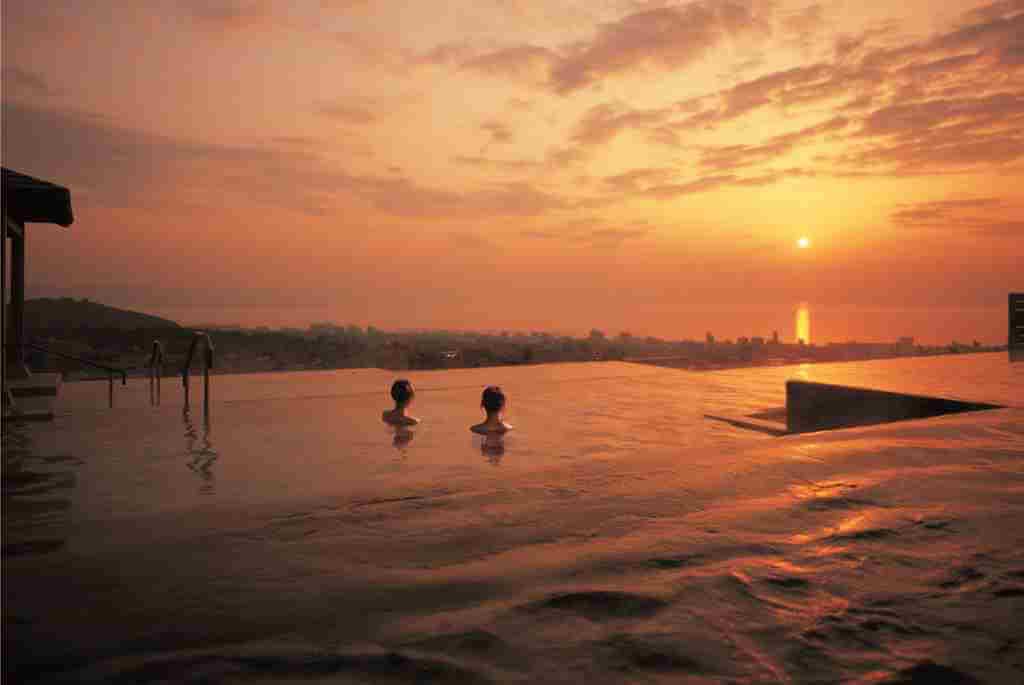
Suginoi Hotel in Kankaiji Onsen, Beppu
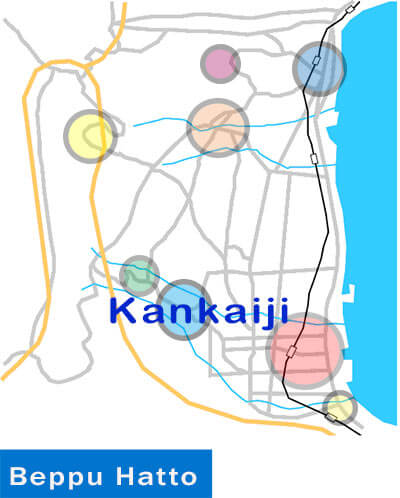
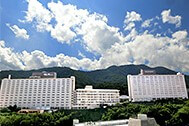
Kankaiji Onsen has the largest hotel in Beppu called Suginoi Hotel = Source: https://www.suginoi-hotel.com/
Kankaiji Onsen is located directly up the slope from central Beppu. Since this district is also on a hill, the view is good.
Kankaiji Onsen has “Suginoi Hotel,” which is a huge hotel that represents Beppu. This hotel used to be operated for large group guests. However, recently, new facilities such as a vast open-air bath with a wonderful view are being reinforced so that individual guests seeking a high-quality experience can be satisfied.
Horita Onsen(堀田温泉)
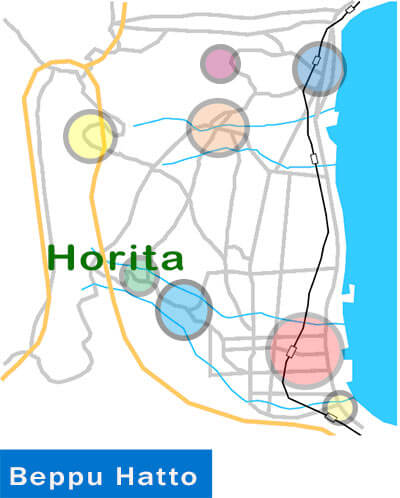
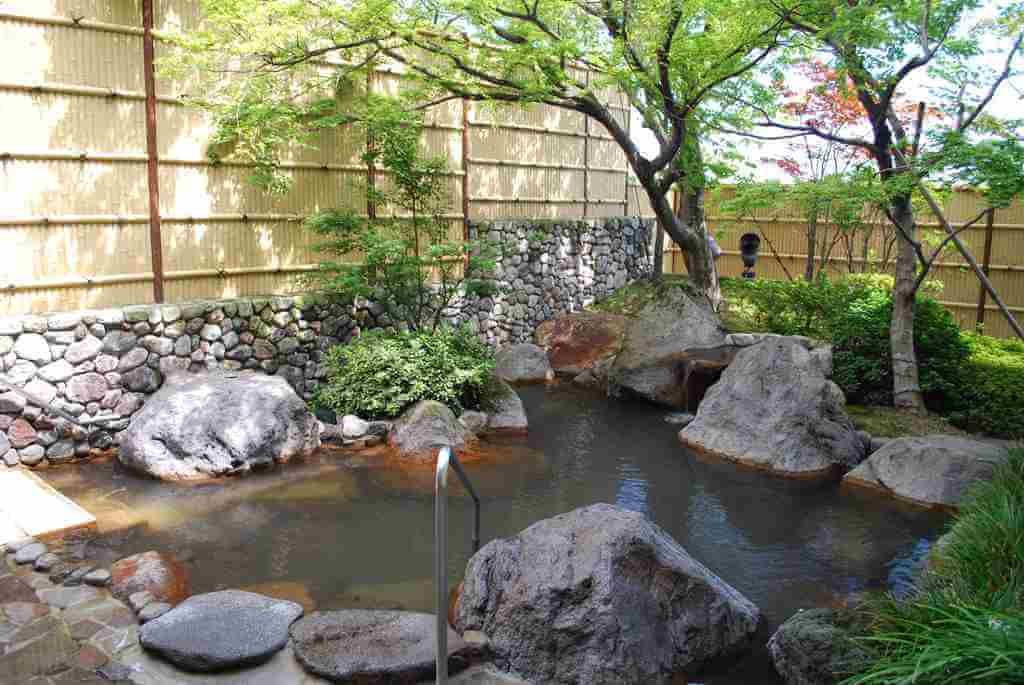
The public bus “Horita Onsen” is one of the most popular public buses in Beppu city.
Horita Onsen is a quiet hot spring located further up the slope from Kankaiji Onsen. This Onsen has been used as a hot spring for healing wounds for a long time. There is a barrier-free public bus “Horita Onsen” here.
Kamegawa Onsen(亀川温泉)

Beppukaihin-Sunayu in Beppu
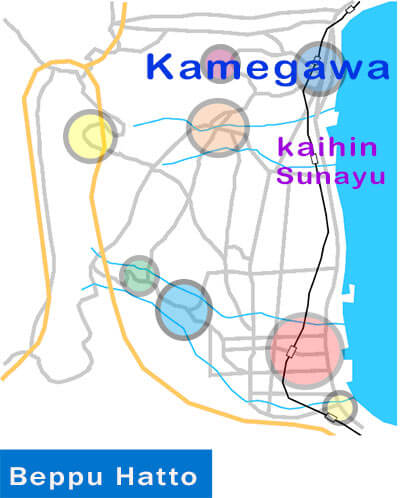
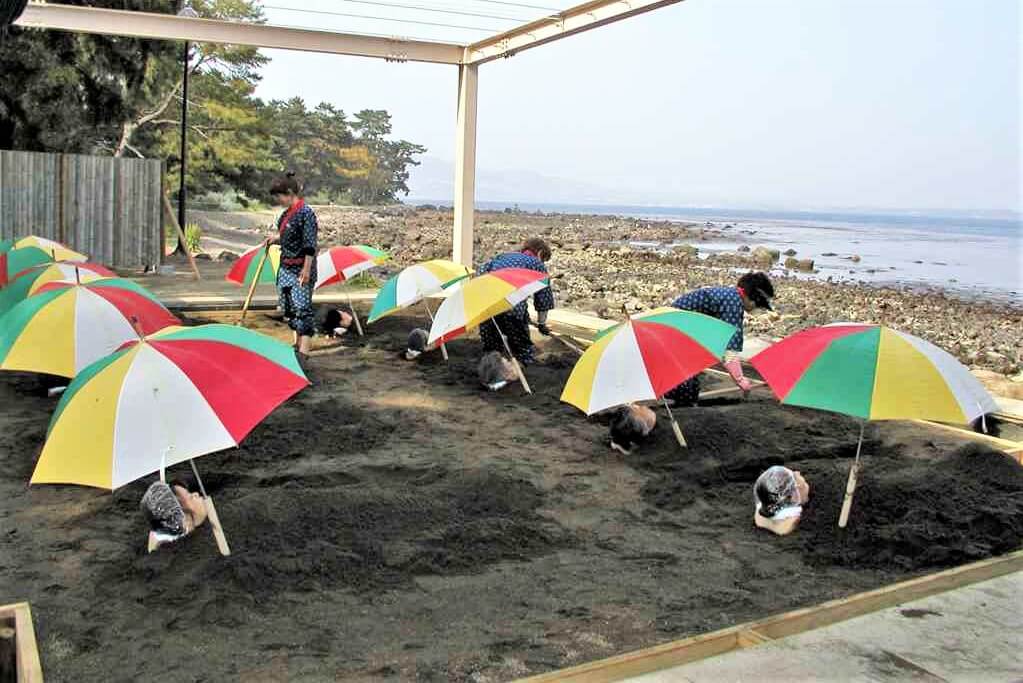
Beppukaihin-Sunayu is located on the seaside away from Kamegawa Onsen
Kamegawa Onsen is located by the sea, right next to JR Kamegawa Station. The old-fashioned public bathhouse “Hamada Onsen” and “the Hamada Onsen Museum” are the highlights of this district.
In addition, there is a municipal hot spring “Beppu-kaihin Sunayu(別府海浜砂湯=Beppu Beach Sand Bath)” near Beppu University Station. It is located on the beach of Shoningahama.
As you can see in the photo above, you can experience the “sand bath” where you can bathe the sand that is warmed by geothermal heat.
Shibaseki Onsen(柴石温泉)
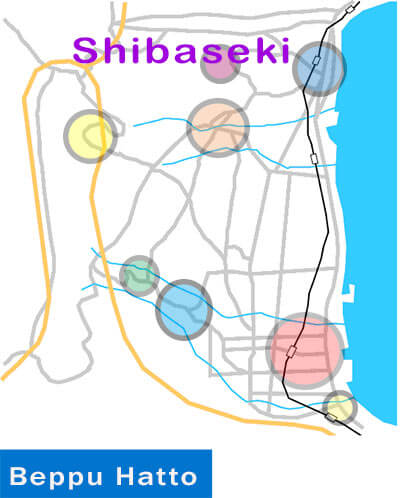
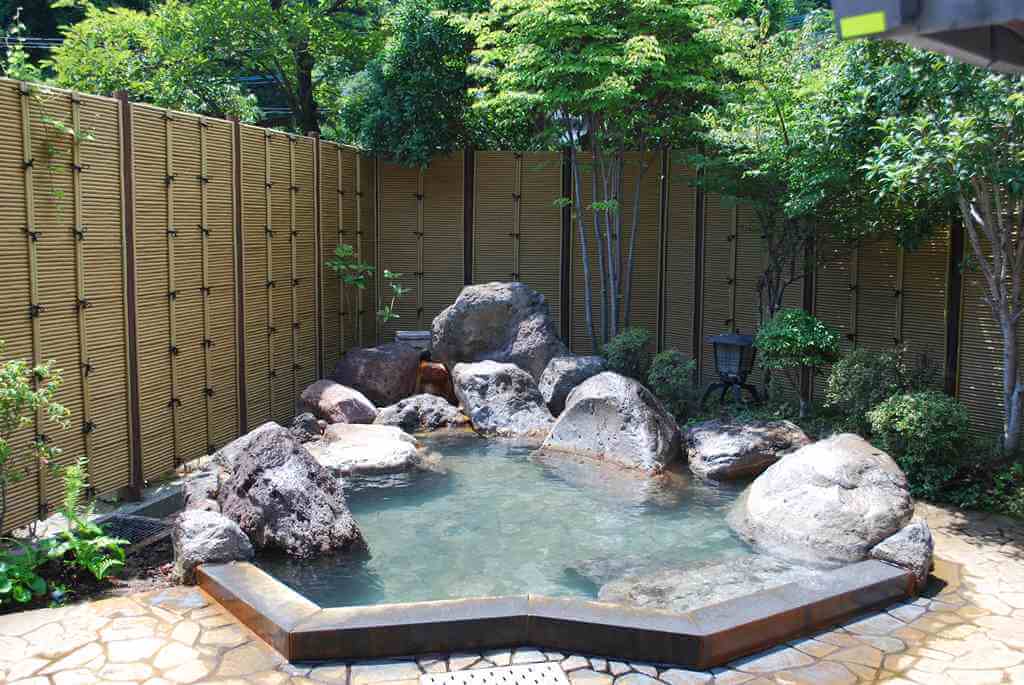
There are no hotels in Shibaseki Onsen, only the municipal public bus “Shibaseki Onsen”
Shibaseki Onsen is a small hot spring just up the slope from Kamegawa Onsen. There is only public bushouse “Shibaseki Onsen” here, there is no accommodation such as hotels.
“Shibaseki Onsen” is used by locals. The atmosphere here is very quiet.
Hamawaki Onsen(浜脇温泉)
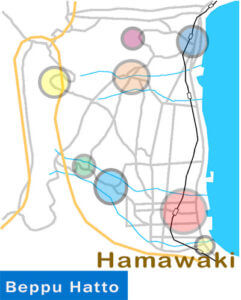
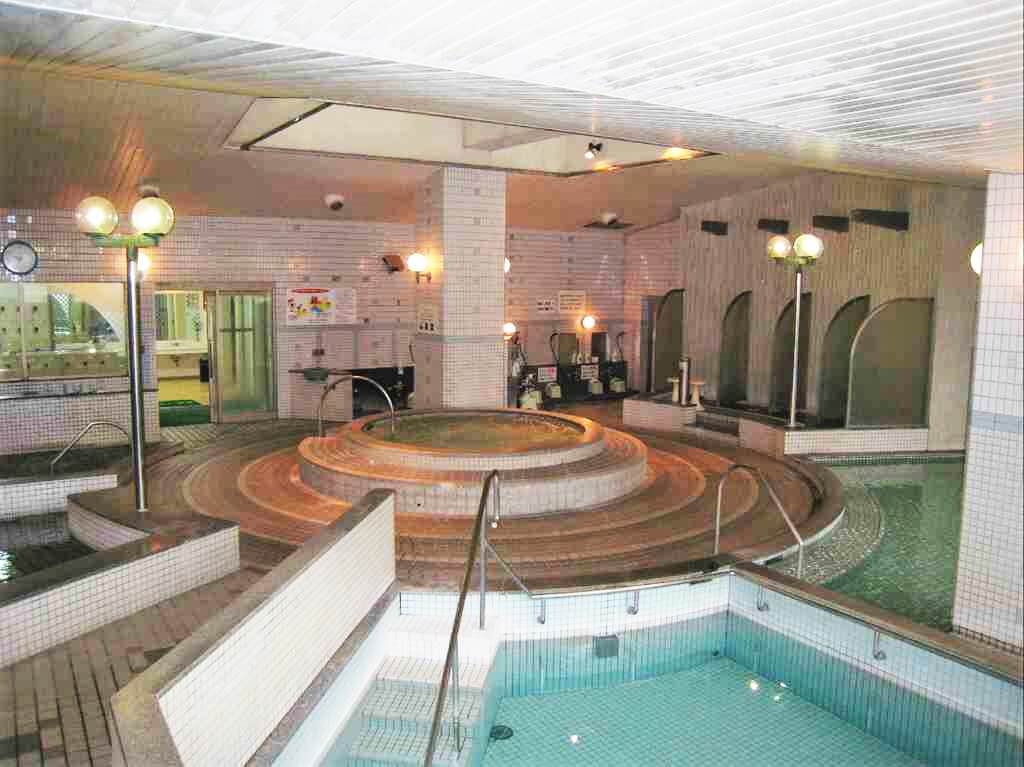
Utopia Hamawaki in Hamawaki Onsen, Beppu. It’s a modern facility with a training gym
Hamawaki Onsen is a relatively small hot spring area located along the southeast coast of Beppu Onsen. “Hamawaki” means seaside in Japanese. It is a 15-minute drive from JR Beppu Station.
The hot springs in Beppu are said to have originated from this district. The old-fashioned Ryokan still remains in this district. But now, the public bath “Hamawaki Onsen” and the hot spring facility “Utopia Hamawaki” equipped with a training gym are the highlights of this district.
Jigoku (Hells)
Beppu has many hot springs with unique colors and shapes. Some of them are used as tourist attractions rather than bathing. They are called “Jigoku (地獄= Hell)”. The following 7 are the representative Jigoku. Five of these are in Kannawa Onsen and the other two are in Shibaseki Onsen.
The five Jigoku of kannawa Onsen can be walked around. Two Jigoku of Shibaseki Onsen can also be moved on foot. You may take a bus or taxi between the two Onsen.There are bus tours around Jigoku so you can join them.
Umi Jigoku (海地獄= Sea Hell)

Many tourists See the blue hot spring water. Call Umii jigoku (Sea hell) That has smoke all the time Is a hot spring that has mineral cobalt = Shutterstock
District: Kannawa Onsen
Umi Jigoku (Sea Hell) is a bright cobalt blue hot spring. The temperature is 98 degrees Celsius and its depth reaches 200m. This Jigoku was born about 1,200 years ago when Mt. Tsurumi exploded. It is the largest of Jigoku in Beppu. If you want to go see one Jigoku somewhere, Umi Jigoku is recommended.
Address: 559-1 Kannawa, Beppu
Access: 20 minutes by bus from Beppu station. Get off at “Umi Jigoku” or “Kannawa”
Entrance fee: 400 yen (Adults, Individual)
Business hours: 8:00 to 17:00 (Open all year round)
Chinoike Jigoku (血の池地獄 = Blood pond hell)

Chinoike Jigoku or Blood pond hell in Beppu= Shutterstock
District: Shibaseki Onsen
Chinoike Jigoku (Blood pond hell) is a popular tourist spot along with Umi Jigoku (Sea Hell). This Jigoku has a red color, like blood, because of the hot red mud containing iron oxide and magnesium oxide. Ashiyu (foot bath) of the same color is also available.
Address: 778 Noda, Beppu
Access: 15 minutes by bus from JR Kamegawa station. Get off at Chinoike Jigoku. / 40 minutes by bus from Beppu Station. Get off at Chinoike Jigoku. Taxis are also available at both stations.
Entrance fee: 400 yen (Adults, Individual)
Business hours: 8:00 to 17:00 (Open all year round)
Tatsumaki Jigoku ( 龍巻地獄 =Tornado Hell)
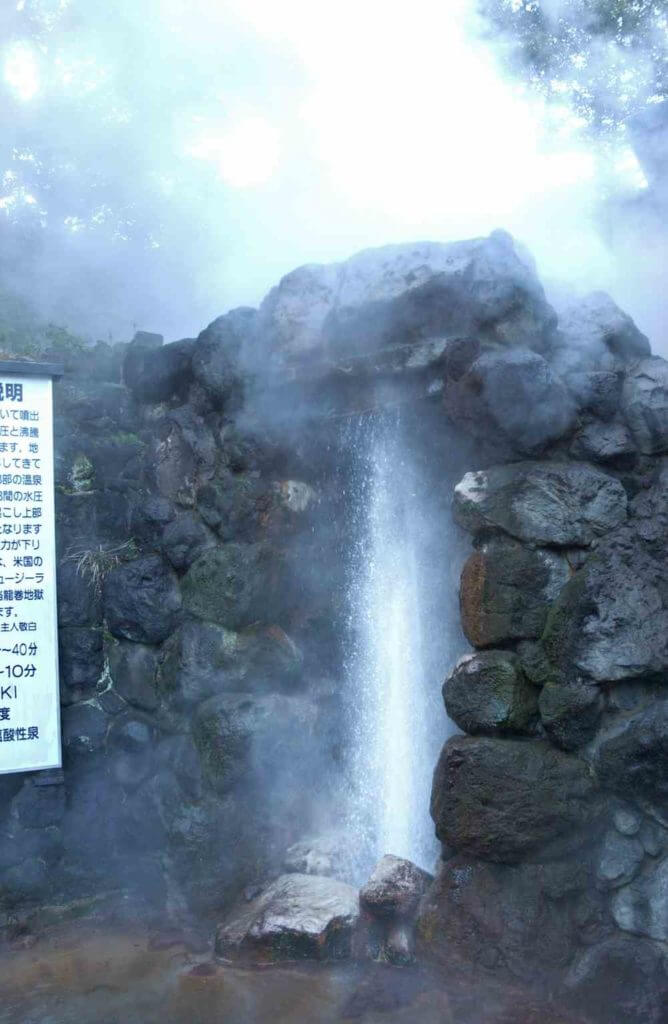
Tatsumaki Jigoku in Beppu
District: Shibaseki Onsen
Tatsumaki Jigoku is a geyser that erupts every 30-40 minutes. This hot spring has the power to eject from the ground to a height of 50m. However, to prevent the dangers of tourists, the Jigoku now has a stone ceiling and walls on the sides, as seen in the photo above. The force when Tatsumaki Jigoku gushes is tremendous.
Tatsumaki Jigoku is right next to Chinoike Jigoku above. 10 minutes before the eruption, the red lamp at the entrance will light up, so it’s a good idea to use this lamp as a reference when deciding which Jigoku to see first.
Address: 782 Noda, Beppu
Access: 15 minutes by bus from JR Kamegawa station. Get off at Chinoike Jigoku. / 40 minutes by bus from Beppu Station. Get off at Chinoike Jigoku. Taxis are also available at both stations.
Entrance fee: 400 yen (Adults, Individual)
Business hours: 8:00 to 17:00 (Open all year round)
Shiraike Jigoku (白池地獄 = White Pond Hell)

Shiraike Jigoku in Beppu
District: Kannawa Onsen
Shiraike Jigoku (White Pond Hell) is a hot spring that contains borate salt spring. It is transparent when it gushes, but it turns milky when exposed to the outside air.
Address: 278 Kannawa, Beppu
Access: 20 minutes by bus from Beppu station. Get off at “Kannawa”
Entrance fee: 400 yen (Adults, Individual)
Business hours: 8:00 to 17:00 (Open all year round)
Oniishibozu Jigoku (鬼石坊主地獄)
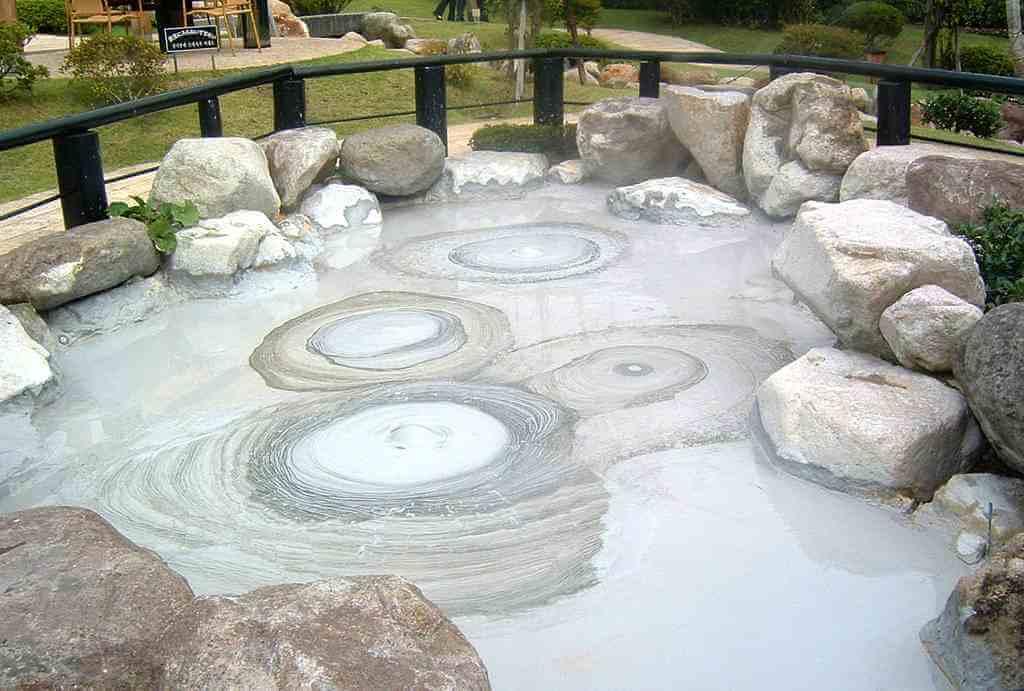
Oniishibozu Jigoku in Beppu
District: Kannawa Onsen
Oniishibozu Jigoku is close to Umi Jigoku (Sea Hell). At Oniishibozu Jigoku, you can see a strange sight, as if the gray mud is boiling. It is commonly called Bozu Jigoku because it looks like Bozu (a monk’s skinhead). Oniishibozu Jigoku has a hot spring facility “Oniishi-no-yu” (620 yen for adults).
Address: 559-1 Kannawa, Beppu
Access: 20 minutes by bus from Beppu station. Get off at “Umi Jigoku” or “Kannawa”
Entrance fee: 400 yen (Adults, Individual)
Business hours: 8:00 to 17:00 (Open all year round)
Kamado Jigoku (かまど地獄)

Kamado Jigoku in Beppu
District: Kannawa Onsen
Kamado Jigoku means “Cooking Pot Hell” when translated into English. It was named after cooking rice using steam of this Jigoku for the festival of a certain shrine. There are several hot springs in this hell. The colors of these hot springs are various, such as mud, milk, and blue.
Address: 621 Kannawa, Beppu
Access: 20 minutes by bus from Beppu station. Get off at “Kannawa”
Entrance fee: 400 yen (Adults, Individual)
Business hours: 8:00 to 17:00 (Open all year round)
Oniyama Jigoku (鬼山地獄)

Oniyama Jigoku in Beppu
District: Kannawa Onsen
Unlike other Jigoku, Oniyama Jigoku is more focused on the crocodile bred by using the heat of the hot spring rather than the sight of the hot spring. About 80 crocodiles will welcome you.
Address: 625 Kannawa, Beppu
Access: 20 minutes by bus from Beppu station. Get off at “Kannawa”
Entrance fee: 400 yen (Adults, Individual)
Business hours: 8:00 to 17:00 (Open all year round)
Yukemuri Observatory
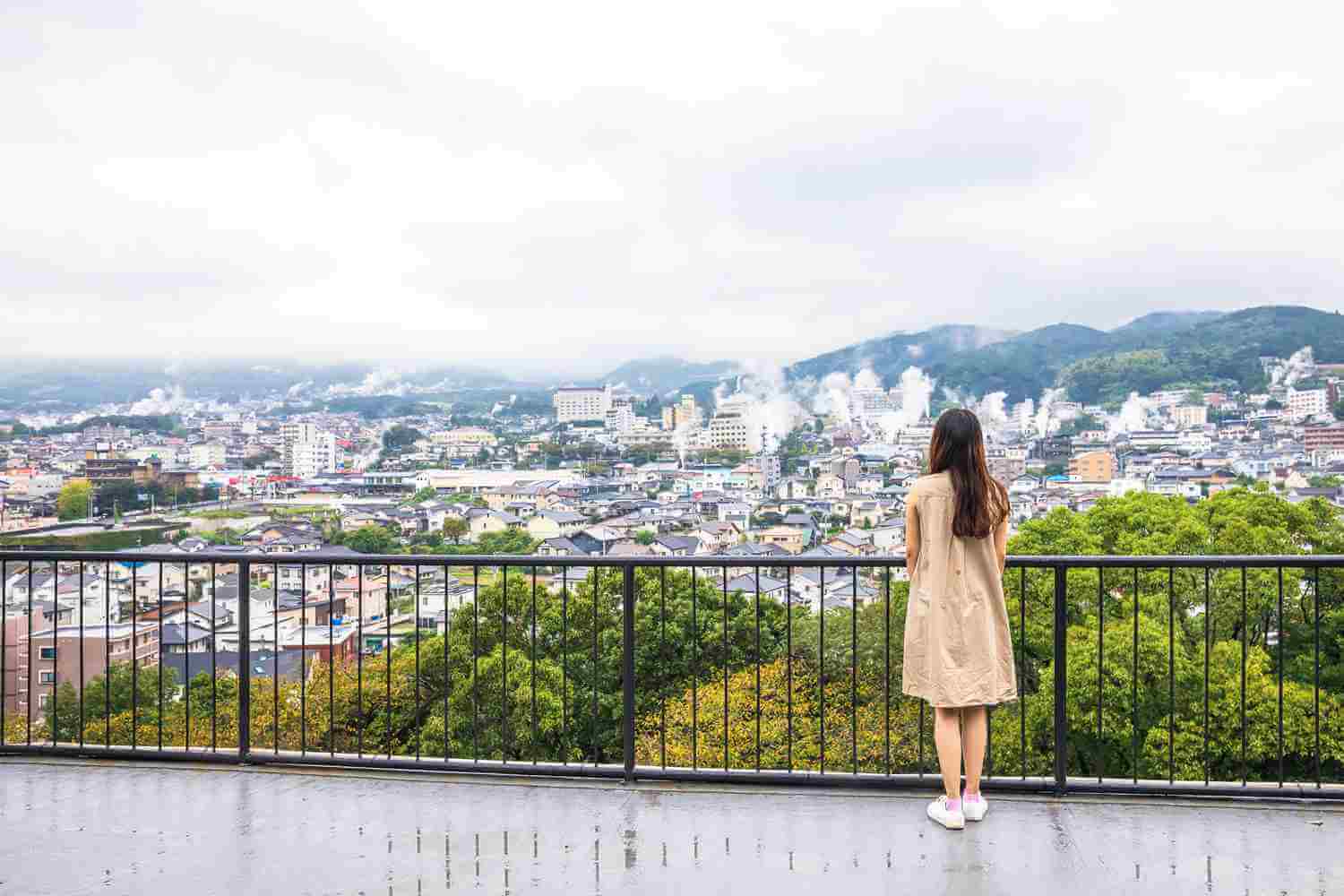
Female tourists at the viewpoint of Beppu, Japan’s No. 1 hot spring town, a city with Steam drifted from public baths and ryokan onsen= Shutterstock
On the hill of Kannawa Onsen, there is a scenic spot called “Yukemuri Observatory” where you can overlook this hot spring town. If you visit this observatory, you can enjoy the view of hot spring steam rising from here and there, as seen in the picture above. As you can see in the top photo on this page, the fantastic night view with steam illuminated is worth a visit.
Information about Yukemuri Observatory
access:
Kannawa East Group 8, Beppu
20 minutes walk from the center of Kannawa Onsen.
20 minutes by car from JR Beppu Station
Parking
Free
April-October: 8: 00-22: 00
November-March: 8: 00-21: 00
Jigoku Steaming Workshop Kannawa
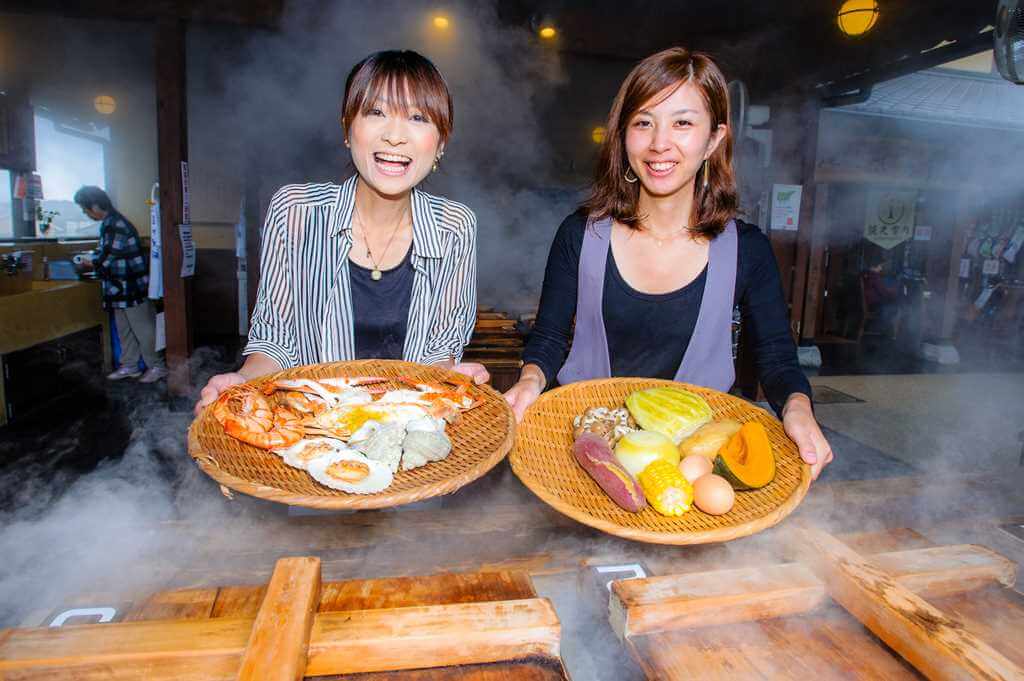
Enjoy delicious “Hell Steam Cuisine” at “Jigoku Steaming Workshop Kannawa” in Kannawa Onsenn, Beppu
Beppu has a traditional cooking method called “Hell steamed food” that uses hot spring steam. Kannawa Onsen has a facility called “Jigoku Steaming Workshop Kannawa” where tourists can experience this cooking method by themselves.
Information about Jigoku Steaming Workshop Kannawa
access:
5 sets of bath books in Beppu (along Ideyu slope)
About 20 minutes by bus from JR Beppu Station. Get off at “Kannawa”
business hours:
9:00 to 20:00 (Last reception 19:00 for hell steamer)
* The final reception time may be earlier depending on the congestion.
* Please note that reservations are not accepted.
Menu / Price
1) Charges for using the hell steamer
Basic usage fee (20 minutes or less)
- Jigoku steamer (small): 340 yen
- Hell steam pot (large): 550 yen
2) Ingredients
Ingredients can be purchased at the facility. Below are some examples.
- Seafood Plate: 2,000 yen ~
- Red King Crab Deluxe: 3,900 yen
- Shabu Beef: 3,000 yen
Mt. Tsurumi (鶴見岳)& Beppu Ropeway
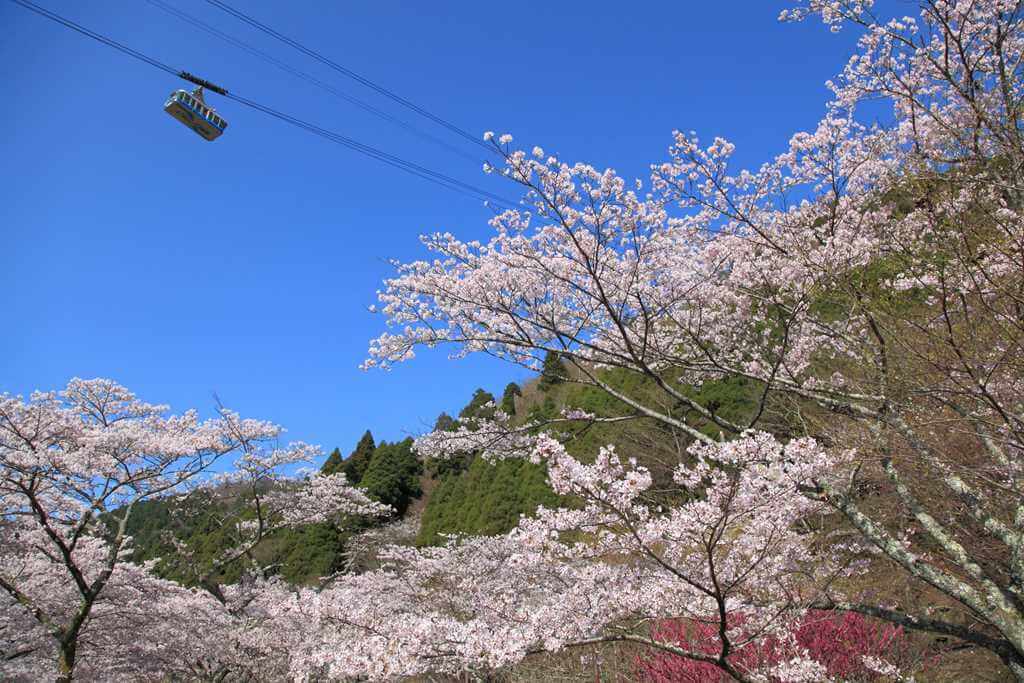
It takes about 10 minutes to reach the top of Mt. Tsurumi by Beppu Ropeway

With Beppu Ropeway, you can enjoy such a magnificent landscape
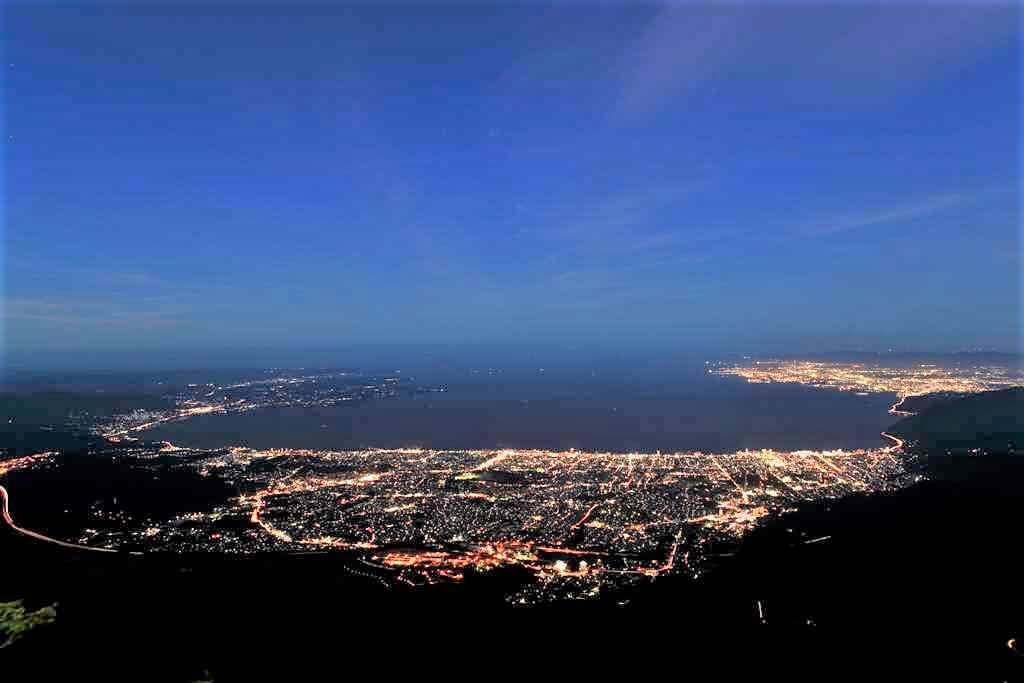
The night view is also wonderful
In Beppu, there is a mountain called Mt. Tsurumi with an altitude of 1,374.5m. Beppu ropeway runs to the mountaintop. Using this ropeway, you can reach the summit from Beppu Kogen Station at the foot in about 10 minutes. From the top of the mountain, you can see a wonderful landscape below. The night view is also beautiful.
Information about Beppu Ropeway
Beppu Kogen Station(別府高原駅)
Access:
10-7 Aza-Kanbara, Oaza-Minami-Tateishi, Beppu-city, Oita
20 minutes by bus from JR Beppu Station
Summer season: March 15th-November 14th
- First departure 9:00
- Last ascent 17:00
- Last descent 17:30
Winter season: November 15th-March 14th
- First departure 9:00
- Last ascent 16:30
- Last descent 17:00
Thank you for reading to the end.
If you are interested in a tour program that includes Beppu in your itinerary, please click here.
Now, let’s plan to make your vacation in Japan the best experience ever!
